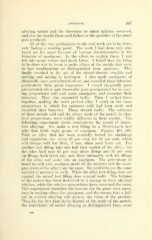Page 633 - My FlipBook
P. 633
AMALGAM. 307 ;
alloj'ing metals and the directions in which failures occurred,
and also the results from such failure in the qualities of the amal-
gam produced.
All of this was preliminary to the real work yet to be done
only finding a starting point. The work I had done only con-
fused me the more because of various inconsistencies in the
behavior of amalgams. In the effort to explain these, I was
led into many errors and much labor. I found that the thing
to be done was to learn to make alloys of the metals that were
in fact combinations as distinguished from mixtures. This
finally resulted in the use of the closed electric crucible and
melting and mixing in hydrogen. I also made amalgams of
chemically pure precipitated silver, and recorded their behavior,
particularly their great expansion. I mixed chemically pure
precipitated silver and chemically pure precipitated tin in vary-
ing proportions cold and made amalgams, and recorded their
behavior. They also expanded badly. Then I melted these
together, making the most perfect alloy I could in the same
proportions in which the mixtures cold had been used, and
recorded their behavior. These shrunk badly. The mixtures
of these metals cold and the alloys made of the metals in iden-
tical proportions, were totally different in their results. The
following experiment shows conclusively the result of imper-
fect alloying. We make a test filling in a Wedelstaedt test
tube that holds eight grams of amalgam. Figures 401, 402.
Take an alloy that has been carefully tested for shrinkage
and expansion, say silver 65 per cent, tin 35 per cent, which
will change bulk but little, if any, when used fresh cut. For
another test filling take one half that needed of the alloy; for
the other half take 65 per cent silver filings and 35 per cent
tin filings, both fresh cut; mix these intimately with the filings
of the alloy and make into an amalgam. The percentage of
metal in each (the amalgam made of the mixture and the amal-
gam made of the alloy) are the same. Be careful to use the same
amount of mercury in each. "\^Tiile the alloy test filling does not
expand, the mixed test filling does expand badly. The balance
of the metals has been destroyed by a change in their physical
relation, while the relative proportions have remained the same.
This experiment furnishes the reasons for the great care neces-
sary in making alloys for amalgams, and the reason that a fail-
ure in perfect alloying will destroy the value of the product.
Then for the first time in the history of the study of the metals,
the importance of actual alloying as distinguished from mere
411)


